Wheat Levain and Kamut Boules Baked in the Wood-fired Oven
Last Monday and Tuesday Alison and I were joined by my family who came up to help with a number of projects we have on the go just now. Many thanks to my Mum and Dad and Brother and Sister-in-Law, for all their help. The initial project which dragged them up from northern and eastern corners of Yorkshire to the far north of England was to try to make some improvements to the firing efficiency of my wood-fired oven. My family have watched and supported me from afar in my summer baking antics, and I believe my brother’s offer to try to improve the potential of the oven was an offer of genuine enthusiasm to help me expand my own baking activities in the longer term.
Whilst the rest of us slaved away inside, Dave dismantled the chimney section of the oven, modified the design and then re-built it. We built a small fire on the second afternoon to verify that things had improved; they had!
After my first 3 day stint in Leeds and a lovely Saturday evening entertaining friends at home with a lovely South Indian Fish Curry, I had some time to fire up the oven properly over 2 days, and bake bread in it.
I fired the oven gently on Sunday, then somewhat harder today in the gales resulting from an always unwanted hurricane emanating from the US and blasting over from the Atlantic. The chimney seemed none-too-stable, but the fire roared nicely in the end.
My leavens had been a little neglected, so it was a good time to spend re-building their strength too. I have a number of different speciality flours in the store cupboard at the moment, some in just very small amounts; others I held slightly more of. These were left over from the TFL baking course at Newcastle College which ran near the end of July, just before my escape.
I decided to make some bread using the half kilo of Kamut flour I had in stock. Andrew Whitley (2006; pp.87) explains that it is
“Considered to be an ancient relative of durum wheat, Kamut is the registered tradename for a cereal derived from 36 grains mailed by an American airman in Egypt to his father in Montana in the 1950s. Its production is always organic and is controlled by the Quinn family. Kamut is generally higher in protein than wheat but with poorer-quality gluten.”
I used a flour mix consisting of 30% Kamut, 20% Gilchesters’ Pizza/Ciabatta flour and 50% Carrs Special CC Bread Flour. The leaven was made with the bread flour, and the amount of pre-fermented flour was 20%. I suspect this was a trifle too low. I began with 50g of stock levain which was built to 530g over 14 hours and 2 refreshments. Hydration was in excess of 71%.
Here is the formula, recipe and method:
Material | Formula [% of flour] | Recipe [grams] |
1. Levain; 2 refreshments |
|
|
TOTAL | 32 [flour 20, water 12] | 512 [flour 320, water 192] |
|
|
|
2. Final Dough |
|
|
Levain | 32 [flour 20, water 12] | 512 [flour 320, water 192] |
Gilchesters’ Pizza Flour | 20 | 320 |
Carrs Special CC Flour | 30 | 480 |
Doves Farm Organic Kamut Flour | 30 | 480 |
Salt | 1.75 | 28 |
Organic Salted Butter | 1 | 16 |
Water | 59.38 | 950 |
TOTAL | 174.13 | 2786 |
% pre-fermented flour | 20 | - |
% overall hydration | 71.38 | - |
FACTOR | 16 | - |
Method:
- Mix the flours for the final dough with the final water required, and autolyse for one hour.
- Combine the autolyse with the levain, salt and butter and mix gently to a dough. Develop by hand-mixing a further 10 minutes.
- Bulk proof the dough covered for 5 hours [leaven portion too low!], with one S&F after 1½ hours and another after 3½ hours.
- Scale and divide into 2 x 1.04 kg pieces and one piece just over 700g. Mould round and place upside down in prepared bannetons.
- Final proof, covered for 3½ hours
- Tip each loaf gently out of the banneton onto the peel, cut and bake in the wood-fired oven for 50 minutes.
- Note that I used a wet tea towel to line the oven door as a source of steam; this was primitive, but worked surprisingly well.
- Cool on wires after taking photographs. Cut the loaf open far too early under temptation and enjoy a slice splattered with butter well before you really should!
These were very tasty loaves indeed!! Oven spring was good, although the dough had been a trifle slow to prove all day. Here are the photographs; not perfect, but the oven is well on the way to being able to perform how I always hoped it would.
So, all in all, a good few steps forward.
Codruta asked me about the “factor” in the table on the last post and I forgot to answer; sorry Codruta! The factor is the number that is used as a multiplier to move from formula to recipe. In this case, it is 16; so the total flour is 1600g, from 100%.
Best wishes to all
Andy
- ananda's Blog
- Log in or register to post comments
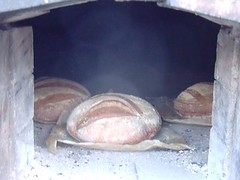

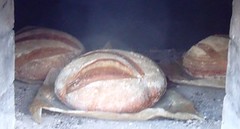
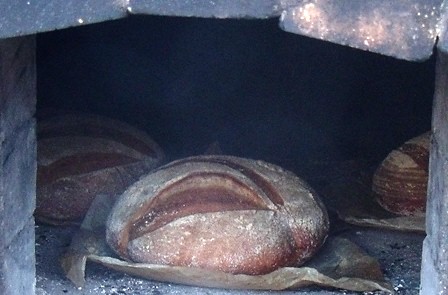
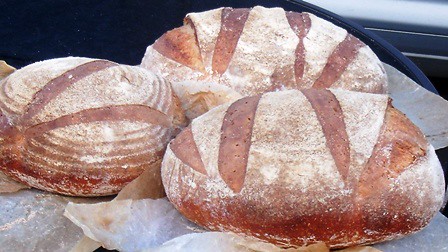
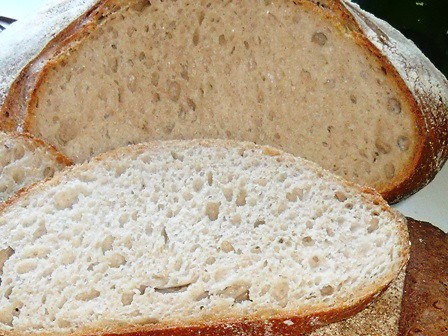

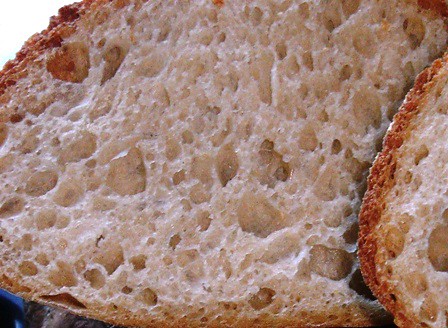
Can't be better than that, Andy! Fabulous looking boules from this fine oven! Fine baking, Andy.. Top Notch!
How did the Kamut taste? was it pronounced?
I'am completely sold on your recommendation of increasing leaven precentage on most recipes. I suspect that Hamelman limits most of his prefermented flour percentage to 15-20 out of scheduling necessities. Now, i always increase my prefermented flour to 22-25%. It works better!
Thanks again, Andy!
Hi Khalid,
I'm pretty sure I know why Hamelman settles for a lower % of pre-fermented flour. Firstly his leavens and sours are used very regularly. Secondly, he makes commercial sized batches, which makes a huge difference, I can assure you! In other words he is assured of excellent levels of activity within the ferment. Always have it in mind that Hamelman's work is first and foremosted addressing the professional baker. Homebakers need to make some allowances, and one I make when baking at home is to change leaven amounts accordingly.
For Kamut, see reply to Nico below.
Always very good to hear from you, and, as ever, thank you so much for your generous words.
Best wishes
Andy
Beautiful loaves, Andy, with wonderful oven spring. Looks much loftier than the breads you've shown us baked in your domestic oven. Maybe because of very hot oven floor? (do you use baking stone in your domestic oven?)
Never used or tasted Kamut but always been intrigued. How does it taste like?
Do you know what the temperature was like in the oven?
lumos
Yes, you are quite right lumos.
I didn't tend to get much spring in the old electric oven, so usually tried to compensate with full fermentation before baking. I usually found that loaves were prone to blow-outs if I didn't fully ferment at final proof.
The new SMEG oven is much better, but not fully tested yet. I have a new baking stone arrangement, consisting of a firebrick cut cross-sectionally into 3. Put these together and it forms the perfect sized rectangle.
The spring in the wood-fired oven was pleasing, but I so wish I'd used a bit more leaven in the formula to increase % pre-fermented flour to say 25 - 27%.
Regarding Temperatures, I have recently bought one of the Infra-red gun thermometers so I did take readings; as follows:
When I set the oven the top heat was 245*C and the bottom was 235*C.
I baked the 3 loaves first, and only took a second temperature reading after 1.25 hours to see how solid the heat was and give me a picture of how the oven was functioning.
The top heat had held around 230*, but the bottom heat on the oven floor had dropped to around 200*C. I was pleased that the heat was even, no obvious hotspots or coldspots. However, the drop in bottom heat is now the thing I need to get right. I am thinking that the best solution is to introduce a time element of really intensive firing once the fire in the oven is well-established. There is plenty of insulation in the oven, so that isn't a problem. A really solid metal door and an effective chimney cover are also an essential acquisition for the future.
Good question; thanks for asking that one!
All good wishes
Andy
Hi, Andy! Thanks for the reply and the detailed explanation.
Surprised to know the temperature was not as high as I'd expected. Wondered about it, though, because you said it took 50 min to bake those. Never had any experience with WFO, except for (possibly misled?) pre-conception; WFO great for pizza = must be very high temperature. Also read other TFLers' posts about WFO remarking very high temp in their ovens. So are the temperature mainly controlled by how intensively you pre-heat the oven before use?
lumos
Hi lumos,
You are very much on the right lines. However, the overwhelming concept to get your head round is the notion of "stored" or "solid" heat.
You could fire the oven for a fairly short period and still have the chamber really hot. However, the heat would be lost very rapidly. This is the ideal scenario for pizzas in many ways. However, the traditional derivation for a pizza is as a rustic snack which the baker can bake and then eat as he/she waits for the oven to settle ready for baking bread.
Ideally, if an oven has been fired properly, the heat should hold for some time. That being the case the production schedule is based around firing products such as pizzas, rolls etc first..items which bake fast so can cope with intensive top heat. The bigger loaves follow on behind. Confectionery goes through last on the dead oven.
So the headline temperature can be misleading. A hot oven, long-fired will burn products and the temperature will take an age to drop. However the headline figure could be just the same in an oven fired for a short period of time. This means the heat will be lost much quicker in this situation.
All good wishes
Andy
Andy! That loaf has risen so much as to stand up from the base, and the crumb speaks clear regarding the oven spring.
I never use kamut because I have a deep antipathy for it: how can you trademark a cereal? Does it taste differently from a good durum wheat flour?
Hi Nico,
Thank you as always for you very kind words.
Kamut: this is really the first time I have personally baked with it, although I did work with a student using it fairly recently. In both instances it was included around 30% of the total flour, so as a flavour adjunct rather than all-encompassing. Alison and I really liked the taste of the bread, and we were really naughty and ate a slice each spread with butter whilst still slightly warm from the oven!!! I am rarely drawn by such temptation.
A good durum wheat flour? Well, it's ok for you, but I suspect the only good durum flour I have used for bread baking is the tumillia! I have used a few "00" type flours, but that does not necessarily indicate durum, or, good quality, I'm sure you'd agree.
Yes, I agree that flour in general should not be trademarked. However, if you note Jamie's comments below, you will realise that an important aspect of the brand is to maintain integrity and quality as the product is intrinsically both organic and wholegrain. I am happy to support both these aspects. Additionally, like spelt, the grain has not been "tampered" with by our scientist friends. As such, it has been reported often by those who suffer with wheat/gluten intolerances that these alternative grain varieties are more digestible and cause no suffering. This is also important to me.
Very best wishes
Andy
Wonderful bake Andy, I am quite jealous of your oven and baking skills too :)
If my parents weren't so much like Gypsies moving around all the time, I'd try and get them to help me build a wood fired oven in their backyard. At least right now though, they are alright with holding my 'commerical bakery' items in their garage, and thats all I can ask for.
Always enjoy your post,
Arlo
Hi Arlo,
Thank you for your very kind words, although be assured there is no need for jealousy!
As a student and now a professional baker making his way, I take an equal interest in your own posts and progress. I wish you well, and anyone else who is taking a similar path within our trade. You are our future, in an industry I have so far given 24 years of my own working life to.
I so look forward to the day you post on how those bits of kit currently stashed in the garage are put to use in your own bakery. The very best of luck to you in the future.
Andy
Woah, beautiful breads! And I am so envious of your WFO!
Hi txfarmer,
I wonder if working on a wood fired oven may be a little too much in the Texas heat?
If not, well it could be your next project?
Very good to hear from you
Best wishes
Andy
Andy you must be thrilled at the even heating in your WFO. The crusts look all the same top and bottom, very nice. If the heat mass is solid and well insulated I suspect you will be able to better soak the heat mass with longer firings using a smaller fire after the initial burn. There isn't an absolute necessity for a chimney and you sure would want to close it off to prevent heat loss. What a great family project. I'd sure like to see how your improved WFO looks now.
Cheers,
Eric
Hi Eric,
Yes, the evenness of the baking and the amount of spring in the loaves are the most pleasing aspects directly explained by the influence of the oven.
Whilst the chimney pipe is not essential for the function of the oven, I suspect I'd probably have a few irate neighbours round complaining about the smoke in the vicinity if I dispensed with the chimney. It definitely helps with the draw of the fire, and it does help to take the smoke upward, and so out of the way. I am wary of causing any sort of nuisance with the oven.
Regarding the new appearance, some photos below; although outwardly, it has changed only a little. The chimney is now much tidier. When I first built it, I was rushing to complete the chimney in the most terrible rain, and it made the work almost impossible.
Above: Front view of the oven
Below: Left the inner workings of the new chimney arrangement, and right the front view of the new chimney.
Yes, family support has been and will remain invaluable, and much appreciated, of course.
Always a pleasure to hear from you
Best wishes
Andy
Congratulations Andy!
Not only for getting the WFO up and running the way you wanted, but for baking such marvelous looking breads in it the first time out after repairs. They certainly had a good 'jump' once they hit the deck didn't they? Beautiful looking translucent crumb, and a wonderfully porous crust that speaks of all kinds of flavour. I've never used Kamut myself, but these breads of yours are a powerful inducement to finally try it out. Interesting information regarding Kamut. I had the notion it was something else entirely, not expecting it to be as white as it is.
How large is the interior space of your WFO, and how many 1-1.5K loaves do you think could be baked at a time in the oven? I'm trying to get an idea of what sort of dimensions I'll want for whenever I get around to building my own WFO.
Great baking from your skilled hands as always Andy!
All the very best,
Franko
Hi Franko,
So good to hear from you and thank you very much, as ever, for your very generous words.
Kamut (R); yes, you should try it if you have an easy source. It is finely milled and quite light in character if that makes any sense? It does only form 30% of the flour grist, and the Special CC is pretty white, although the Gilchesters isn't at all white. It was really hard to get a representative crumb shot, as the weather turned foul very soon after I snapped the other shots above, so I took the crumb photos in my dark kitchen.
The internal dimensions of the oven, approximately, are 700mm x 700mm. I reckon I could get 6 loaves of the size you mention in at once, with careful setting.
Very best wishes
Andy
Superb, Andy. You just KNOW it tastes beautiful when it looks like that. Must be great to have a WFO in your backyard...not to mention breads like those coming out of it! Bet you're a popular lad with the neighbours!
Cheers
Ross
Hi Ross,
many thanks for stopping by, it's really good to hear from you.
Yes, I really hope I can make much more use of the brick oven now. And I hope that means I can generate a small number of local regular sales along the way too.
A gradual business launch per chance?
All good wishes
Andy
Greetings
from the Kamut International Team in Montana!
You
are receiving this e-mail because you have posted a recipe that includes a
KAMUT® Brand flour. The recipe
sounds amazing – your baking skills with a wood-fired oven are evident in your photos.
After monitoring our website, www.kamut.com, we have found that our recipe page is one of the most viewed on our
website. We would love to include your recipe and credit your work withyour name and url/blog address. We appreciate your creative and delicious
recipes and hope we can work together to promote good food and each other’s websites. If you are interested in promoting your website in
this way please email me the following:
1. The recipe and title
2. A photo of the dish
3. The name or website you would like to receive credit
4. Your website link
Should you ever have more recipes containing KAMUT® that you would like to share, we would be happy to post them! I wish you all the best! Thanks!
Thank you for properly noting that Kamut(r) is a brand and not a wheat variety.
KAMUT® is the name of the BRAND, not the wheat. One of the biggest misconceptions about KAMUT® Brand khorasan wheat is that the name “Kamut” refers to the type of wheat, while in fact, KAMUT® is the trademark name. Bob Quinn, Founder of Kamut International, wanted to assure the quality of the organic, heirloom grain, khorasan wheat.
Under the brand KAMUT®, consumers know they can trust this wheat will always be grown certified organic, will always be non-GMO, and will never bealtered or modified. KAMUT® brand khorasan wheat is grown under strict production guidelines and every field is tested for high quality standards.
My kind regards - Jamie
Hi Jamie,
Thank you so much for making such a generous request.
I will send you a PM by way of reply, if that's ok?
Best wishes
Andy
Hello Andy,
What a feeling of joy and satisfaction it must be to craft such beautiful loaves, and bake them in your very own
wood-fired oven. The results are outstanding.
:^) from breadsong
Thank you so much breadsong.
Yes, there is an added dimension to baking when the wood-fired oven comes into play; no doubt about that!
The advantage is I can bake 6 loaves at a time, instead of just the one!
All good wishes
Andy
I'd say your wfo is in good health by the looks of those breads. Nice scoring, great looking crust and beautifully open crumb. It's great being able to eat the fruits of your labor - and to share something so good with those who labored alongside you.
Nice bake,
Larry
Hi Larry,
Yes, I am pleased with how these loaves have turned out, and thank you very much for your comments regarding the qualities of these loaves. It is very much appreciated, as always.
Only Alison and I get to enjoy these loaves, although a couple staying in the holiday cottage opposite our house took interest in my firing and baking activities, so they got a warm buttered slice each as well!
Mum and Dad live well over 200 miles away and Brother and Sister-in-Law live 100 miles away. They missed the boat...sadly!
Very good to hear from you as always
Best wishes
Andy
Hi Marcus,
I added butter at just 1% in the formula. It was a kind of insurance policy rather than anything else. I have little experience with kamut and thought a small amount of fat to protect the gluten would be a wise move. It added just a bit to the final flavour in the loaf too.
Many thanks for your kind words
Best wishes
Andy
and baking, Andy!
I have been looking forward to your wfo baking! What gorgeous loaves you have formulated and baked in your wfo.
It's wonderful you have the support of your family in your wfo building and baking.
Working with mother nature, as your expressed, does play it's own challenges, too!
How about the neighbors too : ) ... I bet a loaf of bread or pizza would keep them extra content smelling the wfo at work. The smoke issue blows away quickly in a few minutes after the fire ignites. I was so happy to find that out. Most of the time the only clue my neighbors have Im using my wfo is the wonderful smell of roasting and baking, or a pizza arriving..I now give a days notice for pizza arriving at dinner time.
What a successful project and how fortunate your family to have such a talent to build your own oven. Nothing beats having a jack of all trades around the home fires!
Flues and chimney's, IMHO...play 'one' of the most important factors in a wfo. Placed outside the oven chamber can make it a bread/pizza oven, inside the oven chamber it becomes a fireplace, with no flue or chimney, there will be a lot of smoke, flame and heat, coming out in your face and up the front of the oven entrance. Using a 'steel flue' cut to various heights and added to the chimney can help to direct smoke up even higher and away...plus the addition of a 'spark arrestor' is very important, placed on of the chimney is the law in my neighborhood and does give me a lot of peace of mind.
Thank you very much for posting this blog on your WFO baking : ) Your breads are gorgeous, as always!
Sylvia
Hi Sylvia,
Thank you very much for your comments, they are much appreciated as always.
Yes, I attach a 1.5m pipe on top of the chimney when firing and it makes a tremendous difference to the effectiveness of the draw, as well as taking the smoke away.
I don't think our neighbours behind would appreciate my bread, and that tends to be the direction that the smoke goes.
The weather is about to turn in the UK now, but I still hope to get some good use from the oven now and moving forward. Afterall, baking 7 loaves at a time is much better than being restricted to just one!
Very best wishes
Andy
Andy, It's great to see you back to baking in your WFO. What fabulous results. And perfect expansion of your loaves - this time in a WFO instead of a deck oven. I wonder how you feel the two compare. Interesting information about Khorasan Wheat. Next time I see it I'll be very tempted to reach for it, after seeing what you've made of it. -Varda
Hi Varda,
What an interesting question.
Both ovens work in quite similar ways, in that the conducted heat is of prime importance, especially in hearth breads where the products is set directly onto the floor of the oven.
The key difference is in the level of retained heat, or the "solidity" of the heat in the oven. The base of the deck oven is constructed from virtually the same material as the firebricks used to construct my oven. But the thickness of the base tile in the deck oven is less than a quarter of that of the brick. Additionally the insulation all round and the beehive shape of my oven provide for excellent radiated heat as well. The deck oven is fabricated from steel, so is therefore reliant on fresh heat supplied at the call of the thermostat. Wood fired ovens don't have such a thing!!!
Lovely to hear from you
Best wishes
Andy
That's great looking bread Andy. Really nice of your family to come and help fine tune your oven. They obviously fully support you in your career and your general bread making endeavours.
Best,
Syd
Thank you for your generous comment Syd
Very good to hear from you
Best wishes
Andy
Andy, I like so much when you post about your breads. The stories behind breads are so nice, it's a real pleasure to read you and learn from you, in the same time.
ps: in fact you answered to my question about "factor", but this time you explained better.:)
I was planning to make your Gilchesters Miche this week, but this post might make me change my mind. I have a bag (500g) of Farina di Kamut (prodotto biologico "il Molino Chiavazza", gift from my sister-in law) and I didn't know what to do with it... now I do. Do you recomand another ratio of levain in the formula? Please note, that here the weather is still hot, maybe I won't need so many hours for the fermentation, if I'll go with your formula, as it is. What do you think?
best wishes, as always,
Codruta
Hi Codruta,
The Gilchesters formula was really designed to make a loaf akin to the Miche, such as the one described in Hamelman's book attributed to James MacGuire, or the famous Poilane loaf. The obvious attributes to such a loaf are high extraction flour of provenance, use of a natural levain only to ferment the dough slowly and high hydration. I would encourage you to make such a loaf and am sure you would do a very fine job.
However, since you happen to have kamut in your storecupboard, then why not use it up making your next bread? I look forward to reading all about it here, and on your own blog too.
As always, many thanks for commenting in such a generous way.
All good wishes
Andy
Andy, if you see this comment in time... Gilchesters’ Pizza Flour is a durum flour? what flour should I use if I don't have Gilchester? (I have french T65, french T80 and semolina-durum). Thanks in advance for your answer.
codruta
French T65 is nearest.
V brief. on a train and internet connection rubbish
BW
A
thanx, Andy, right on time! :)
codruta